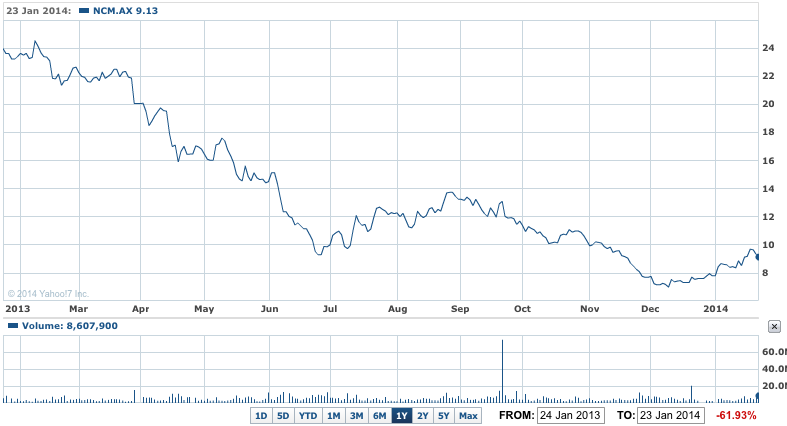So can you trust Newcrest Mining (NCM), the perennial underachiever of Australian mining, no make it Australian investing, since it took over Lihir several years ago?
Yesterday’s December quarter and half year production report was greeted enthusiastically by some analysts and media, who coyly refused to acknowledge the way Newcrest has destroyed billions of dollars of shareholder value since the Lihir deal, especially with the $6 billion plus of write downs, losses and impairments last year.
Newcrest shares fell in yesterday’s sell-off, losing 2.2% or 21c, to end at $9.13, traded.
They were much lower in 2013, but they have been much higher – above $42 when the Lihir deal was done at the end of 2010 at a cost of more than $9.2 billion.
With that background, plus the untidy debacle about whether the company briefed some analysts in advance of the write down losses announcement last June, Newcrest is now being positioned as a ‘new’ company, under ‘new management’. Well, the board has changed with chairman Don Mercer going and CEO Greg Robinson, who is also going.
Newcrest hopes the new look and approach will start paying off. Yesterday it revealed in its quarterly report that it had lifted production 6% and now expects full year output to be near the top of its guidance range (which would be the best performance for a couple of years).
Newcrest reported gold production of 621,125 ounces during the December quarter, up from 586,573 tonnes in the previous quarter.
It told shareholders that it now expects to produce around 2.3 million ounces of gold during the 2013-14 financial year, which is at the top of its previous guidance (which many analysts and investors doubted it could achieve).
And so long as it meets guidance in the next two quarters, it should make that level of guidance, given gold production in the six months to December was more than 1.2 million ounces.
The main driver of the stronger production was a 27% increase in output from its Telfer mine in Western Australia, while copper production was up 15% to 22,603 tonnes during the quarter.
Newcrest recorded an average realised gold price of $1,372 per ounce during the quarter, while the all-in sustaining cost of production fell 16% to $921 per ounce.
The miner attributed the cost reduction to increased production and sales, and lower levels of production stripping plus sustaining capital and a continuing cost-cutting focus.
But the quarterly report was remarkable for its focus on improved performance from Telfer and other mines, and not the black hole which is also known as Lihir. It took the brunt of last year’s write downs and has proven to be the company’s weak point in its production misses in the past two years.
Typically the production report for Lihir was mixed – compared to the December quarter a year ago it rose sharply, from just over 147,000 ounces to more than 187,000. But compared with the September quarter’s 194,000 ounces, the December effort fell short.
NCM 1Y – Newcrest claims a big improvement – do you believe it?

"Gold production was 4% lower than the previous quarter as a 2% increase in mill throughput was offset by a 2% decline in gold grade and a 4% reduction in gold recoveries. The lower gold grade was the result of a higher proportion of mill feed from lower grade stockpiles during the quarter, while higher mill throughput reflects increased feed rates. Costs rose 9% in the quarter," the company said.
The Telfer mine in WA was the star, as reported above, but that won’t last as lower grades will mean lower gold output this half.
"Telfer’s December 2013 quarter performance was 156,789 ounces of gold and 7,352 tonnes of copper at an All-In Sustaining Cost of A$957 (US$890) per ounce. This compares with the September 2013 quarter performance of 123,691 ounces of gold and 4,485 tonnes of copper at an All-In Sustaining Cost of A$1,296 per ounce.
"Gold production was 27% higher than the previous quarter due to a 21% increase in gold grade, a 9% increase in mill throughput and gold recoveries 3% higher than the previous quarter. The increased gold grade reflects a higher proportion of underground feed to the plant in the December 2013 quarter following the disruption to the hoisting system in the previous quarter. Higher mill throughput reflects lower planned mill maintenance during the quarter.
"All-In Sustaining Cost decrease of 26% during the December 2013 quarter to A$957 per ounce primarily reflects increased production and sales volumes, the completion of the production pre-stripping program in the open pit during the quarter, higher by-product credits net of associated realisation costs, and continued cost reduction efforts.
"Telfer gold production volumes are expected to be lower in the second half of the 2014 financial year due to expected lower gold grades."
So production from Lihir and other mines in Australia, Indonesia, PNG and Africa will have to rise to make up for the expected shortfall. It’s not easy being Newcrest and having such a reputation for underperformance, is it?
Looking at this report another way, if you accept that Newcrest’s governance has improved as well as its management of its costs and assets, this report could be treated as an upgrade.
Provided the gold price doesn’t tank, it’s likely the company will be looked at in a new light by many investors.
The December half year report next month will however be scrutinised to see if the weaker gold price has forced the company to reduce its reserves of gold.
That has already started happening in early reports from some offshore gold companies.













